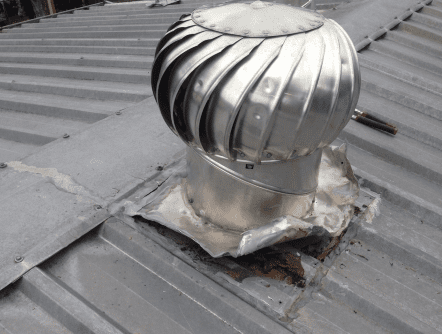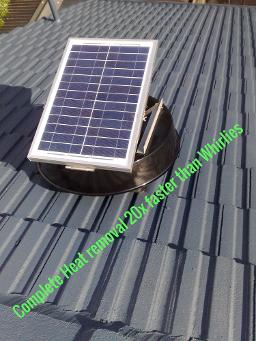A Guide to Whirlybirds - Roof Ventilation and Whirlybirds in your Home
A guide for the curious consumer interested in Roof Ventilation & Whirlybirds
Without a proper means of insulation or ventilation, a standard roof space quite simply traps & accumulates heat as the sun beats down onto your roof. This heat radiates down through your ceiling, will warm your home, and accounts for around 25% to 35% of the heat gain in summer, right next to windows. Obviously, you can install blinds to block heat out of windows, but you can’t put blinds over your roof.
When roof heat starts radiating through your ceiling, your home becomes stuffy and hot. Most homeowners will resort to using air conditioning, though unventilated roof spaces will continue to transfer heat, whilst all that coolth travels to the floor or lower floor floor level. Without a means to keep your home cooler or de-stratification (balanced temps) for longer, your power & utility bills can skyrocket.
Methods to ventilate your roof have changed drastically over the past couple of decades. The product most readers are familiar with is the roof whirlybird. One of the first designs for the whirlybird was patented in 1910 by Samuel Ewart. This design in principle hasn’t changed in decades, as it still relies on wind to make the turbine spin. They may also rely on the expansion of air in your roof cavity from rising temperatures. This system can fail drastically when used in multiples as one unit draws out air and the others draw in roof surface temps.
HOW DOES A WHIRLYBIRD WORK?
There’s typically two types of whirlybirds: your mechanical, active-powered whirlybird, and the conventional wind-driven whirlybird. The far more popular conventional whirlybird operates when wind hits the turbine fins, causing the vent to rotate. The motion creates a vacuum that sucks air out of the roof space. Unfortunately, a single whirlybird will not usually suffice for a modern home, and may require up to four or six units to be installed to feel an effect!
It is worth noting however that they can assist in reducing heat build-up as well as humidity while enhancing air movement in your home. The design is also typically able to resist rain, though it isn’t impervious.

Whirly bird Cooling and Rate of Airflow - How effective are they?
Depending on what kind of whirlybird manufacturer or model you purchase, each average whirly bird unit is capable of ventilating around 100-150 m³/h in 12 km/h winds individually. Though, naturally, performance will vary from design to design. These factors may range from how warm the air is in your roof space (for air to expand), whirlybird throat size, wind accessibility, to wear & tear in the whirly bird unit itself. Read more about whirly bird models versus other dedicated ventilators here!
In order to feel the effects of ventilation in your home, you might need around 700 m³/h of air flow to keep your roof space near to the ambient temperature outside. Of course, this means you’ll need more than one whirlybird to do the job.
WHIRLY BIRD COST AND AFFORDABILITY - IS IT WORTH THE EXPENSE?
A standard whirly bird isn’t terribly expensive. You can pick one up from major hardware stores for as cheap as $60.00 AUD, and sometimes their installation can be done DIY. However, affordability often comes with a compromise in the modern market, as cheaply built whirly birds can present design flaws after installation.
Below is a list of downsides that come with purchasing wind-driven whirly bird turbines for roof ventilation:

1. Reliant on Airflow
A whirlybird depends on wind to spin the turbine. Quite simply, if there is no wind, it doesn’t spin properly. On an especially windy day a whirly bird might ventilate your roof to a degree. However, those dry (or humid) summer days when there is no wind will prove the whirly bird inefficient as your roof space bakes under the sun. In locations where strong winds are common such as valleys, a whirly bird performs as expected. Otherwise, it simply isn’t advised. A powered, mechanical whirly bird might help, but their price & running costs have proven to be unattractive to the public.
2. PRONE TO RUNNING NOISILY
Cheap roof whirlybirds aren’t necessarily made to run efficiently, or quietly. As the whirly bird operates, the parts rub and can make low squeaking, or grinding noises. The stronger the wind, the more obvious the noise. On top of this, without regular lubrication, the whirly bird bearings can wear or loosen. Worse still, they can make the whirly bird run louder if said bearings are damaged.
3. Inefficient Design
As explained, roof whirlybirds are inexpensive, though inefficient in moving air through your roof space in comparison to other ventilators. Simply, single roof whirlybirds won’t be enough to ventilate your roof space, and reduce ambient temperature in your home. It would take at least fifteen to twenty residential roof whirlybirds to effectively cool the average-sized Australian home. This many whirlybirds is not only expensive, but ruins the look of the home, as well as makes installation cumbersome & costly.
4. Inclined to Malfunction or Deteriorate
Whirly birds are usually resistant to rain, though their open design can easily catch leaves, dust, or other foreign objects. If enough of this debris enters the whirly bird turbine, it can interfere—and impact the whirlybird performance. Cheaper whirly birds may also rust or can be damaged by severe weather. With maintenance & cleaning, this can be avoided—but are you willing to regularly maintain the fifteen to twenty residential roof whirlybirds needed to keep your home cool?
Solar Whiz - Your Solution for Roof Ventilation
The Solar Whiz is a dedicated self-sufficient solar powered roof ventilator. Quite simply, it provides you with the efficiency of a powered roof whirlybird without the expensive upkeep or power bills. Given that the Australian climate features near-constant sun exposure when it’s hot, the Solar Whiz runs efficiently throughout the day. It even operates on overcast or rainy days!

Around mid-day when the sun is directly overhead is when your roof space generates the most heat. By around 2PM or 3PM, this raw heat will have radiated down into your home. This contributes a large amount of heat to your living space and will continue to do so until your roof space has cooled. Most homeowners rely on air conditioning to keep their living space comfortable. This continued heat radiation will only put more pressure on your cooling to keep up with your needs.
A single Solar Whiz can perform the legwork of ten to fifteen residential whirlybirds, reducing the clutter on your roof. They also run quietly and are designed to prevent foreign objects from getting into the fan system. On top of this, the unit can be mounted on many kinds of roofs—from your common suburban tiled roof to metal roofs!
By investing in a permanent, powerful roof ventilation solution like a Solar Whiz, you ensure that your roof space will stay close to the ambient temperature throughout the day. Given that the Australian climate is renowned for the scorching summer, sunlight is in abundance. By using a sturdy design able to resist the worst that Australian weather can throw at it, a dedicated solar roof ventilator is ideal for your roof ventilation needs.
What about Ventilation for Commercial Properties?
Industrial whirlybirds, on the other hand, with very strong winds operate anywhere from 2,500 to 5,000 m³/h per hour. On average whirly birds need winds of around 8 km/h for a satisfactory performance.
While we provide powerful solar roof ventilation solutions for your home, we also have a commercial ventilation line! We’ve designed them to properly ventilate the extreme heat that large-scale properties can produce. On top of that, our commercial exhaust fans are excellent at adequately ventilating fumes for industrial businesses. Our solar commercial ventilators come in two sizes:
- the SW-RAF7000, capable of moving 7,000 m³/h,
- and the SW-RAF10000, capable of moving a whopping 10,000 m³/h!
If you’re thinking of buying cheap whirlybirds to help ventilate your business, consider a Solar Whiz instead! You’ll be feeling the difference during those hot summer days.
DEDICATED ROOF VENTILATION - THE PRACTICAL CHOICE
The conventional whirlybird is an old workhorse. The aging design has been replaced by far more efficient, dedicated ventilator designs. While they are still produced & used in many Australian homes, more people are turning to solar roof ventilation to meet their home cooling or extraction needs. Documented study has even shown that many of the modern roof ventilator designs cast a shadow over cheap whirly birds.
The Solar Whiz solar-based roof ventilator is DIY-friendly. It is also free to run in the day (while also having night time options). It even comes in a variety of sizes suited to your needs. They can quite easily out-perform fifteen to twenty residential roof whirlybirds.
The century-old idea of using wind to ventilate a roof space has become archived. Why rely on wind to ventilate your home if the sun is the issue? Use the sun to your own advantage—invest in a solar controlled ventilator to manage your home comfortably this Summer.
Interested in Solar Roof Ventilation? Enquire Today



